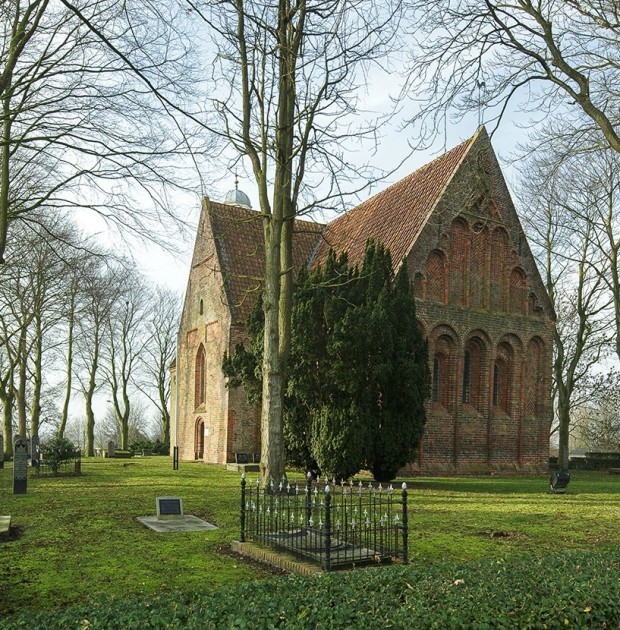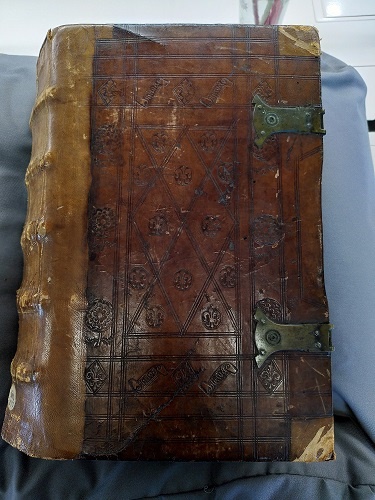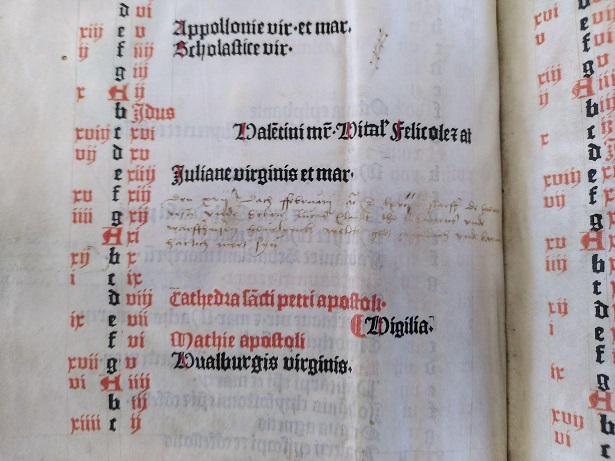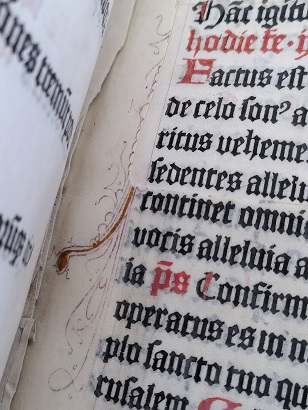A Medieval Missal: CSI Leermens
When I put this Münster missal on a cushion and carefully started to leaf through it, I felt a bit like a medieval Sherlock Holmes. The little stamps on the binding, the notes penned down on the first pages, the Bible texts printed in a Gothic font, the slight damage here and there that has been carefully stitched up: all of these told a story and it was up to me to discover this story and write it down.
At the beginning of February 2022, I started my internship at the Special Collections in the University of Groningen Library. During my internship, I contributed to the Frisia project, which involves digitizing a selection of books from the Special Collections from before 1614. In addition, an online interactive map will locate the places in Frisia that these books have a specific historical relationship with. Those interested can learn more about the stories of Frisia through podcasts, videos, photographs, and narratives. As the name of the project implies, the focus will be on the entire area that once used to be called Frisia, i.e. currently the northern part of the Netherlands as well as Ostfriesland in Germany. I spent several months mapping out these literary locations. One of the books I was working on is a missal dating from 1489, which has been labelled INC 137 in the Special Collections. This missal contains all the texts that were used during mass, plus a calendar with, for example, all the holy days, so that the priest knew exactly what should be celebrated or commemorated on which day.
I obviously handled the missal very carefully. This book has survived for centuries: it has witnessed the discovery of the Americas and the foundation of the Kingdom of the Netherlands. Just the thought of accidentally tearing it in 2022, after all those centuries... If that happened, I would leave the country immediately! But soon I realized there was no need to be this worried: the parchment this book is printed on is still very strong, even after more than five hundred years. So strong even that the pages stand out like a fan if you try to close the book. Thanks to this strong parchment, the book has been preserved in excellent condition, which means there is a lot to tell about its history. So, put on your deerstalker and light your pipe, because we are off on our journey!
The missal was printed in 1489 in Cologne and must have been quite expensive, because parchment was a lot more expensive than paper. Another thing that immediately catches one’s eye is the large size of the missal. This means it will not have been for private use, but for use by priests during a Catholic mass. This missal was specifically printed for the diocese of Münster and contains the correct mass texts and calendar for this area. In those days, this area included a part of Germany as well as a large part of the current province of Groningen. But where exactly was this missal used? In which church could the voice of a priest reading from this book be heard?
At the beginning of the 19th century, archivist R.K. Driessen from Groningen tried to solve this mystery. When he examined the book, he noticed a note at the beginning of the book stating that the missal was used on an altar for the Virgin Mary. He thought that this could mean it belonged to the Akerk in the city of Groningen, which is dedicated to the Virgin Mary. However, it was later concluded that this theory was incorrect. Although a large part of the province of Groningen belonged to the diocese of Münster, the city of Groningen (and therefore the Akerk) belonged to the diocese of Utrecht—meaning that this church would have used a different missal. The notes in the calendar of the book give us more clues. We can read, for example, that one Lucas Clant died in Leermens in 1567. The missal also mentions the day of death of the priest of Leermens. This points us, medieval detectives, to the Donatuskerk in Leermens. This was the home of this missal, at least from 1558 until 1590. Leermens did indeed belong to the diocese of Münster and there is an altar for the Virgin Mary in this church, which is where the book must have been kept. It is clear that the book was used a lot: the parchment has become soft and shiny because the pages have been turned so many times.
And now for the real detective work, as a couple of years later, the missal was a witness to a crime! Yes, there is a crime scene hidden in the pages of this missal. You may have seen it already: the note on the death of Lucas Clant. What happened?
In 1590, according to a note in the missal’s calendar, a woman named Clant who was married to Willem Ubbena died. This is an interesting situation and we don’t know all the details yet, but this is the current theory, as noted in the catalogue for the ‘Hell and Heaven’ exhibition, which was held in the Groningen Museum in 2001. After his wife had died, Willem had a problem: through her, he inherited the debts of her father, Lucas Clant. The death of Lucas Clant, in 1568, is duly noted in the missal. But if Lucas Clant would have died in 1567, instead of in 1568, these debts would not have been a problem for Willem. According to the theory, his wife Alijt Clant would still have been a minor in 1567, in which case she would not have inherited her father’s debts. Willem changed the year of Lucas Clant’s death in the missal to 1567, which was easy, as the year was written down in Latin numbers, which meant he only needed to erase one I. However, Willem’s plan failed: in 1604, the Hoofdmannenkamer (Chamber of Chiefs, a board of justices) of Groningen sentenced him to a fine for forgery. Willem Ubbena wasn’t just anyone, by the way: he was the son of Joachim Ubbena, the mayor of Groningen. The Ubbena Guesthouse (hospice) in Groningen was named after him. It is unclear whether Joachim Ubbena was still alive when Willem committed his crime. If that was the case, he probably would not have been pleased with his son’s antics. It is uncertain whether this theory is correct and it will be difficult to unearth the truth, but it is still a good detective story!

It is unclear where the missal went after this happened. Unfortunately, we don’t know everything about its wanderings yet. We do know that the missal was handled roughly: strips of parchment have been cut off, as have decorated initials in the text. All that is left of these initials are remnants of gold leaf and little scrolls, which show that they must have been decorated lavishly. Maybe these initials were pasted into another book, something that happened a lot in the Middle Ages and the Early-Modern Period. Book printing wasn’t exactly cheap and anything that could be reused was a bonus. The missing parchment strips may have been used in the binding of another book, to strengthen it. These cut and pasted parts are also known as scattered fragments or membra disiecta.
Eventually, the book ended up with the aforementioned archivist R.K. Driessen. After his death in 1832, the book was bought at auction by the University of Groningen Library, where it is now safely kept in the Special Collections. There are still numerous unanswered questions: who cut out the initials and where are they now? How exactly did the missal end up in Leermens from Cologne? Which hands have leafed through the book? Who knows how many more adventures are hidden in the parchment pages of this missal, ready to be discovered. We don’t know—yet.
Literature
• Paul van Capelleveen, “Gedrukt op perkament: uitgever Stols doet internationaal” on the website of the Royal Library at The Hague, 29-01-2016
• Hel en hemel: de Middeleeuwen in het Noorden, red. E. Knol, Jos.M.M. Hermans & M. Driebergen (Groningen 2001)
• Jos.M.M. Hermans, Het middeleeuwse boek in Groningen: verkenningen rond fragmenten van handschrift en druk (Groningen 1981)
• Jos.M.M. Hermans, Boeken in Groningen voor 1600 (Groningen 1987)
• Kees Kuiken, “Leermens herdacht: memorie-cultuur in Fivelgo vóór 1594” in Groninger Kerken (April 2014), pp. 33–40
(This text was first written for the Nederlandse Boekhistorische Vereniging.)




